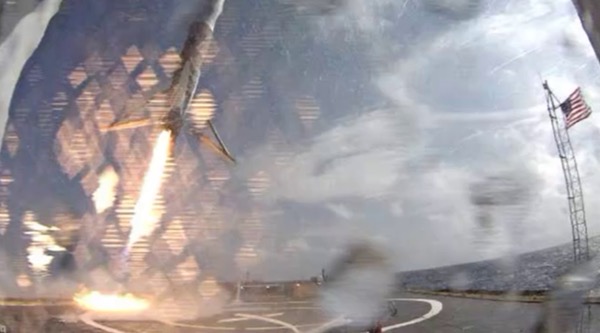How much money would it take to launch enterprise into space?by Sam Dinkin
|
| What if SpaceX can launch enterprise into orbit at that launch price? What do I mean by “enterprise”? |
Rand Simberg has started a Kickstarter campaign to help explain how to clear the road to Mars with a big portion of the blame for the high cost going to the SLS. I’ve donated. As of June 8, he was more than halfway to his goal. But will the road clear itself once the price to orbit drops?
Suppose SpaceX is correct when it estimates that the cost of a launch will drop to $22 per kilogram with the advent of reusability. While that is not 100 times cheaper than a Falcon Heavy’s $90 million for 53 metric tons—that would be closer to $17 per kilogram—it’s still plenty cheap. Is reusability a fantasy? I watched the video of a Falcon 9 lower stage landing on the ship Just Read the Instructions then falling over. Finding out if reusability is fact or fantasy may be a trillion dollar question.
What if SpaceX can launch enterprise into orbit at that launch price? What do I mean by “enterprise”? How about the CV-6 Yorktown-class aircraft carrier Enterprise commissioned in 1938 that fought in the Battle of Midway? It weighs in at 25,900 metric tons. (That’s small compared to the Battleship Yamato’s 71,600 metric tons for those who have been measuring space travel in those terms.) At $22 per kilogram, the mass of the Enterprise would take 436 reusable Falcon Heavy launches to orbit for a total of $570 million. Million with an “m.” That’s less than the cost of seven Falcon Heavy launches at the $90 million list price. The Enterprise only cost $19 million to build back then.
For a little bit more, we can launch the 37,200-metric-ton 1952 reference mission to Mars as proposed by Wernher von Braun. That included 70 people and 10 ships heading to Mars. That would cost only $818 million in launch costs. Yes, million with an ‘m’. That would require 637 reusable Falcon Heavy launches. Fuel cost? As von Braun put it, that’s only 10% amount of the fuel delivered during the Berlin airlift and only cost $4 million in 1952 dollars. He estimated 950 launches.
Let’s think bigger. How about the CVN-65 Nimitz-class nuclear aircraft carrier Enterprise commissioned in 1961? That weighs in at 96,300 metric tons fully loaded. That would cost $2.1 billion in launch costs to orbit. Yes, finally billion with a “b”. That would be 1,622 launches. Note that the aircraft carrier only cost $450 million to build back then. Elon Musk has a net worth of about $12 billion according to Forbes, so if he successfully gets the price to orbit down to $22 per kilogram, he can use his fortune to send the mass of almost 6 Enterprises or 8 Battleship Yamatos to orbit.
For $100 billion we can launch more. Way more. The technical manual for Starfleet as reported by Wikipedia says that the NCC-1701-D USS Enterprise from Star Trek: The Next Generation weighs in at 4.5 million metric tons, which is 4.5 billion kilograms. That would entail 169,811 reusable Falcon Heavy launches for a total of $99 billion. So which is fantasy? $100 billion for a Mars mission or 169,811 launches of the mass for Enterprise D for $100 billion?
A Titan II ICBM only cost $877 per kilogram to LEO. If it was made reusable so it could be refueled and reflown 100 times? $8.77 per kilogram in capital costs. If it was so propellant-efficient that propellant cost was about the same as capital cost like in reusable airplanes? $22 per kilogram seems fantastic, but it only costs $3 a kilogram to deliver something by air freight to Australia. With kerosene at about $0.66 per kilogram, if it takes 2 kilograms of fuel and 7 kilograms of liquid oxygen at about $0.16 per kilograms, then for each kilograms of payload to orbit, I estimate about $2.50 per kilograms in propellant costs to orbit, which makes $22 per kilogram all in seem plausible.
| $22 per kilogram seems fantastic, but it only costs $3 a kilogram to deliver something by air freight to Australia. |
As long as we’re in the teragram mass range, the Great Pyramid at Giza is purported to weigh 5.9 million metric tons, which is about the size of the spaceship in the 1994 movie Stargate. That would cost $130 billon for 222,642 reusable Falcon Heavy flights. It might cost about $5 billion to rebuild a modern version of the Great Pyramid nowadays.
If humanity devoted another $1.375 trillion to, say, spending on launch costs at $22 per kilogram from 2031 to 2103, it could launch the equivalent of more than 10 Great Pyramids into orbit on 3,092 reusable Falcon Heavy flights per year. That would be a nice monument to the current century. At $0.22 per gram to orbit, we could launch 6.2 trillion grams of stone to orbit. Or about 6.2 trillion 1985 first-class $0.22 postage stamps to send 6.2 trillion one-gram $1 bills to orbit. Trillion with a “t”. Surely that would launch enterprise into space.
